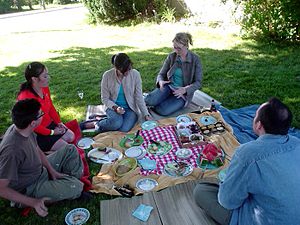
This summer, follow these food safety tips to make sure the only thing you take home from your fun day are good memories! (Photo credit: Wikipedia)
Summer time means eating lots of meals in unusual places. We take picnics, we go hiking. We throw potlucks, we go camping. This is one of the reasons that food safety is such a hot summer topic. When we step out of our normal routine or make meals outside of our standard environment, we may find ourselves in circumstances we did not expect or have not experienced. This uncertainty can be almost as dangerous, from a food safety perspective, as some of the things we believe are food safety facts.
Take a few minutes to review these 7 food safety myths provided by the Partnership for Food Safety Education (PFSE) and sharpen your food safety skills for summer.
Myth 1: Microwaving food kills any bacteria so anything microwaved is safe.
Unfortunately, microwave ovens are not magic. They are subject to the same laws as regular ovens, stove tops, and grills when it comes to food safety. The key to killing bacteria is heat and this is true no matter what source is providing the heat. In order to ensure your food is safe, you need to monitor the internal temperature to ensure it reaches the right temperature. This is just as true for your microwaved foods as it is for the things you cook on the grill. You also need to be extra careful about food safety when using the microwave because food doesn’t always cook evenly, even when you follow all the directions. Take the internal temperature from several locations before determining whether or not your dish is actually done.
Myth 2: All vegetables, even the lettuce and greens that come in a bag, must be washed before use.
While this is generally the case, it is not actually true for those super handy bags of lettuce, spinach, and salad mix you can find in the grocery store as long as the bag is labeled ready to eat or pre-washed. In fact, PFSE actually recommends NOT washing these items at home because you are opening the door to the introduction of contaminants.
Myth 3: Who needs a food thermometer? I can tell something is cooked properly by the way it looks or the way it feels.
While you may have learned to cook from the best chef in town, the truth is that the only sure way you can know if the food you are cooking is safe to eat is to check it with a food thermometer. Why take a chance when the consequences of being wrong can be so dire. Always check food with an internal thermometer prior to serving to ensure it is safe before serving.
Myth 4: Once you thaw something out, you cannot refreeze it.
There is a little truth here but it all comes down to how you thawed it out. If you adhered to proper food safety protocol and thawed the meat in the refrigerator, there is no danger in refreezing it. However, if you thawed is elsewhere, like in the microwave or a bowl of cool water, you do need to cook it or toss it. Whether you are going to use it right away or there is the possibility that you will want to refreeze it later, never defrost raw foods at room temperature by letting them sit out on the counter.
Myth 5: I don’t need to take special precautions because I freeze all my food first, which kills the bacteria.
Unfortunately, not all bacteria is killed off by cold. Some will just freeze along with the food and resume their deadly multiplication once the food is reheated. As previously stated, the only sure way to ensure food is safe is to used a food thermometer to check the internal temperature.
Myth 6: I am a vegan/vegetarian, I don’t need to worry about food poisoning.
This would only be true if animal products were the only source of food contaminants. The truth is that fruits and vegetables can also make you sick. This is why it is crucial to wash every fruit and vegetable under running water before consuming. This includes any items you plan to cut up, even those that contain peels or rinds that you will not be eating. Remember, you have to cut through the skin or rind to get to what is inside and this can drag contaminants from the skin onto the part you are planning to eat. The only fruits and vegetables that don’t need to be washed are those in the bags as outlined above.
Myth 7: Plastic cutting boards don’t hold onto harmful bacteria like wood cutting boards do so using them is safer.
The material that your cutting board is made of is not what keeps it safe. All cutting boards, regardless of what they are constructed of, must be cleaned and sanitized after use.
Related articles
- 8 Tips for a Perfect July 4th Picnic (fillyourplate.org)
- Giving Out God Stars for Food Safety (fillyourplate.org)
- 6 Food Safety Tips This Holiday Season (fillyourplate.org)

